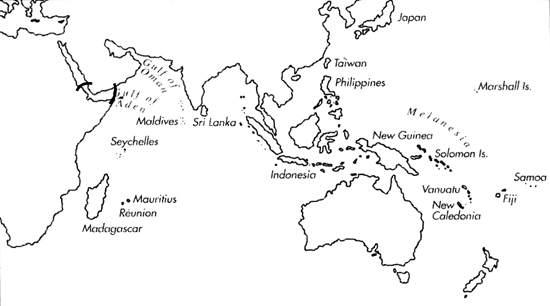Range: S. Red Sea and Gulf of Aden.
Description: Moderately small to medium-sized, moderately light. Last whorl ovate to ventricosely conical, outline convex; left side straight or slightly concave toward base. Aperture broad at base. Shoulder angulate. Spire usually low; outline concave, often with apex projecting from an otherwise almost flat spire. Larval shell of 2-2.25 whorls, maximum diameter about 1 mm. Teleoconch sutural ramps flat to slightly concave, with 0-1 increasing to 5-6 weak spiral grooves. Last whorl with weak spiral ribs at base.
| Shell Morphometry | ||
|---|---|---|
| L | 32-49 mm | |
| RW | 0.06-0.09 g/mm | |
| (L 32-44 mm) | ||
| RD | 0.57-0.66 | |
| PMD | 0.68-0.77 | |
| RSH | 0.07-0.13 | |
Ground colour pale grey. Last whorl with olive to brown axial lines, streaks and blotches, often fusing into a broad interrupted or continuous spiral band on each side of centre. Numerous closely spaced spiral rows of irregularly alternating brown and white dots and dashes extend from base to shoulder. Larval whorls and adjacent 2.5 postnuclear sutural ramps dark brown. Later sutural ramps with light to blackish brown radial streaks. Aperture translucent.
Habitat and Habits: In shallow calm water amongst fine rubble (Sharabati, 1984).
Discussion: C. cuvieri differs from C. fragilissimus and C. obscurus by its broader last whorl (RD 0.57-0.66) and by the absence of shoulder tubercles from its early and later postnuclear whorls. The sympatric C. fragilissimus has a primarily reticulate pattern, while C. obscurus has a generally higher spire with a rather straight outline (RSH 0.11-0.16) and a cylindrical rather than ovate last whorl.

C. cuvieri range map
This section contains verbatim reproductions of the accounts of 316 species of Conus from the Indo-Pacific region, from Manual of the Living Conidae, by Röckel, Korn and Kohn (1995). They are reproduced with the kind permission of the present publisher, Conchbooks.
All plates and figures referred to in the text are also in Röckel, Korn & Kohn, 1995. Manual of the Living Conidae Vol. 1: Indo-Pacific Region.
The range maps have been modified so that each species account has it own map, rather than one map that showed the ranges of several species in the original work. This was necessary because each species account is on a separate page on the website and not confined to the order of accounts in the book.